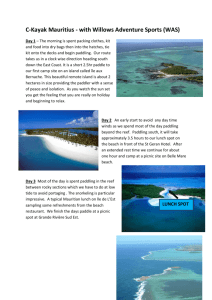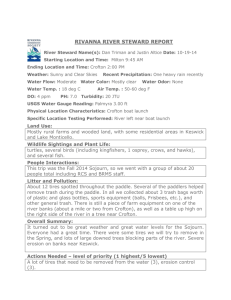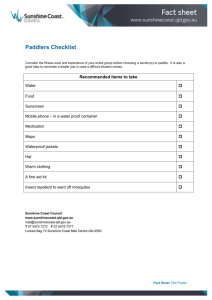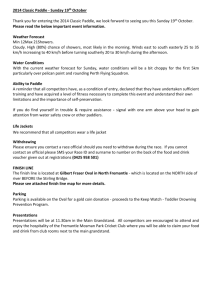Dressing for Cold Water not the Air
advertisement
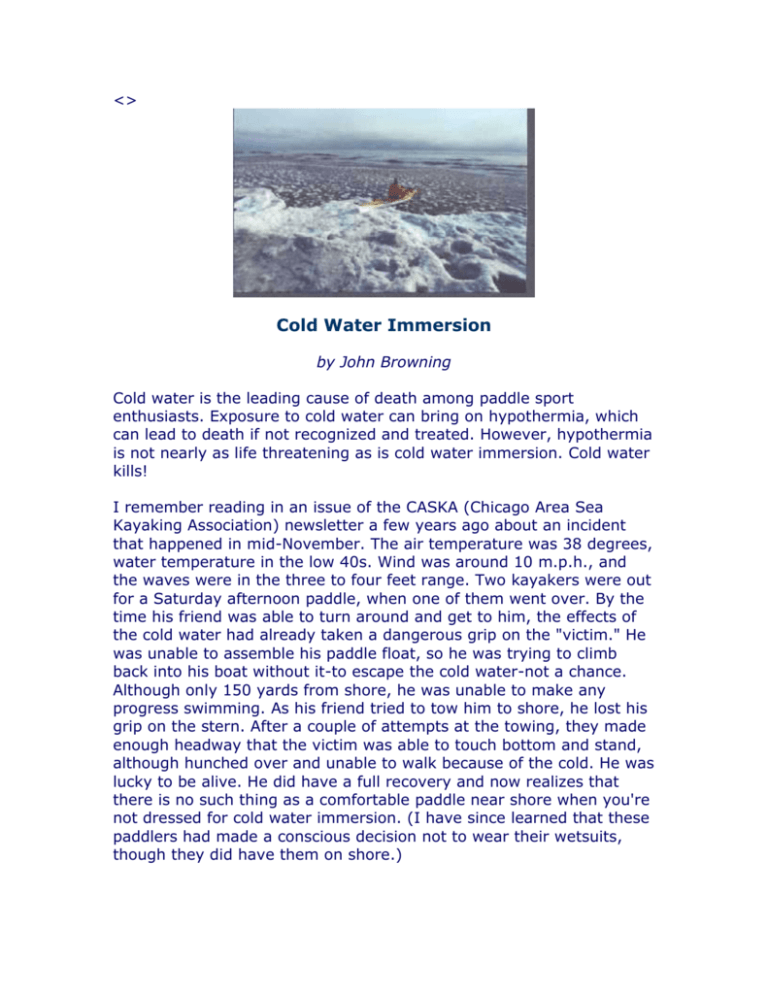
<> Cold Water Immersion by John Browning Cold water is the leading cause of death among paddle sport enthusiasts. Exposure to cold water can bring on hypothermia, which can lead to death if not recognized and treated. However, hypothermia is not nearly as life threatening as is cold water immersion. Cold water kills! I remember reading in an issue of the CASKA (Chicago Area Sea Kayaking Association) newsletter a few years ago about an incident that happened in mid-November. The air temperature was 38 degrees, water temperature in the low 40s. Wind was around 10 m.p.h., and the waves were in the three to four feet range. Two kayakers were out for a Saturday afternoon paddle, when one of them went over. By the time his friend was able to turn around and get to him, the effects of the cold water had already taken a dangerous grip on the "victim." He was unable to assemble his paddle float, so he was trying to climb back into his boat without it-to escape the cold water-not a chance. Although only 150 yards from shore, he was unable to make any progress swimming. As his friend tried to tow him to shore, he lost his grip on the stern. After a couple of attempts at the towing, they made enough headway that the victim was able to touch bottom and stand, although hunched over and unable to walk because of the cold. He was lucky to be alive. He did have a full recovery and now realizes that there is no such thing as a comfortable paddle near shore when you're not dressed for cold water immersion. (I have since learned that these paddlers had made a conscious decision not to wear their wetsuits, though they did have them on shore.) So, if we do become immersed in cold water what can we expect? And how do we prevent these dangerous, and perhaps lethal, situations? First, what do we mean by "cold water"? You may have heard the myth that if the sum of the water temperature and the air temperature equals 100 degrees Fahrenheit, then there's nothing to worry about. Right? WRONG!!! As an illustration of of how wrong this is, let's look at a spring time example . You're paddling on Lake Michigan, out in Whitefish Bay, the water temperature is 50 degrees and the air temperature is 75-it is a really nice day and there's not a lot of wind either. Let's see. . .50 plus 75 equals 125. On the mythical cold water scale you are OK since the sum of the air temperature and water temperature is greater than 100 degrees Fahrenheit. You reach around to get another water bottle off the deck just behind the cockpit. The bottle is secured under the bungee cord and as you give it a tug the bottle comes loose and flies out of your hands. You instinctively grab for it, reaching a bit too far and you roll over in your boat. Having draped your paddle across your lap, you don't have it to execute a roll. So you do a "wet exit". Since it is a fairly calm day and pretty warm by our standards, you did not put on a wet suit, or a dry suit. You did have the good sense to put on your PFD (personal flotation device, aka lifejacket), but besides your swim suit and spray skirt that's it. Our body's response to immersion into 50 degree water is something we don't have a lot of control over. Breathing response. The shock of the cold water causes you to gasp-it literally takes your breath away! The cold water triggers involuntary gasps for air, followed by hyperventilation. Within fifteen seconds hyperventilation can reduce blood levels of carbon dioxide which leads to respiratory alkalosis, which can diminish blood flow to the brain, resulting in confusion, dizziness, and possible loss of consciousness. Hyperventilation can also cause tetany which is a tingling and numbness beginning in the hands and feet that can progressively develop into severe cramping in the extremities. Along with the hyperventilation, there is a claustrophobic feeling of not being able to get enough air (subjective dyspnea). This continues for up to three minutes before beginning to gradually decline, but increases the potential for panic and disorganized behavior in the water and makes hyperventilation even more difficult to control. Hyperventilation increases the rate of breathing four to five times the normal resting level within 30 to 60 seconds of immersion. Research on cold water immersion finds that it takes up to 5 minutes for "relaxed" volunteers to stabilize their breathing at around two times the pre-immersion level. Since fear and panic aggravate the shock response, it is very likely that in real survival situations victims actually experience greater difficulty stabilizing their breathing than the research subjects did. Another threat in cold water immersion situations is the reduction in the length of time that one's breath can be held. The ability of an average person to hold their breath in water colder than 60 degrees Fahrenheit is in the range of 15 to 25 seconds, approximately onethird of normal. It has been further reported that a person in water at 41 degrees Fahrenheit was reduced from 45 to 9.5 seconds. One subject's ability was reduced to 0.2 seconds! This obviously has an impact on one's ability to escape from a capsized boat in cold water. Cardiac and circulatory response. Besides the loss of breathing control, immersion in cold water increases the heart rate, cardiac output, and blood pressure. The heart rate and blood pressure increase within several seconds of immersion. These changes place a considerable strain on the cardiovascular system and increase the risk of heart failure and stroke for people with high blood pressure, weak or damaged hearts, or weak blood vessels. Skeletal and muscle response. Another response our bodies have to cold water immersion is the constriction of the blood vessels in the skin and skeletal muscles. This establishes an outer "shell" that cools more quickly than the "core" where our vital organs are. However, this results in a cooling of the muscles and the nerves controlling them, which leads to slower, weaker, poorly coordinated movements. The ability to swim or tread water is greatly impaired. The inability to continue swimming commonly occurs within ten to fifteen minutes after immersion in water colder than 50 degrees Fahrenheit. Besides the effect on the ability to swim, immersion in cold water for more than ten minutes (five minutes in icy water) lessens our ability to climb onto a floating object or to catch and put on a PFD, or rescue device. And, to properly inflate, attach and use a paddle float. During the first 15 minutes of immersion, the initial effects are mainly a function of skin temperature as it rapidly cools to and stabilizes just above the water temperature. After approximately 15 minutes, the core temperature begins to drop which we call hypothermia. Immersion in cold water is associated with a high rate of heat transfer from skin to water, at least 100 times greater than in air of the same temperature. Thus the importance of dressing for the water temperature, not the air temperature. "Dressing for the water temperature", means wearing protective clothing to minimize heat transfer to the water. For cold air we put on multiple layers of clothing that trap air around our body and are thus insulative from the cold. When immersed in cold water, the water quickly replaces the warm air trapped in these multiple layers of clothing, unless we prevent water from reaching them by wearing a dry suit. Dry suits are made of either waterproof coated nylon or nylon laminated with Gore-Tex. These are generally one piece garments with a large zipper running diagonally from the shoulder down to the waist. The openings at the neck, wrists and ankles are sealed with latex gaskets that prevent water from entering the suit. The zipper, being the largest opening, is extremely critical to the waterproof integrity of the dry suit. Dry suits are made to keep water out, protecting the insulative clothing from becoming wet and ineffective. While dry suits are expensive, if you plan on paddling in cold water, you should use one. Another note about drysuits, follow the manufacturer's care instructions, especially about using 303 Protectant on the latex gaskets and the proper care and storage of the zippers. If you plan on paddling in water that is cool, as opposed to cold, (i.e., in the 50 to 65 degree Fahrenheit range) a wetsuit of either neoprene or polar fleece will do. Depending on the air temperature, wind and wave action (which has some bearing on how wet I'll get from the splashing and spray), I will use additional layers on my upper body for greater protection. Insulation layers, vary from wearing a short sleeve T-shirt made of the latest fibers (i.e., polyester, not yesterday's old stinky polypro)--which I am virtually never without--to a heavier fleece top. For water and wind protection, I wear either a short sleeve top made of Activent™ (an extremely breathable, water resistant material), or when I need full arm coverage, I put on a Gore-tex paddling jacket--complete with latex gaskets at the wrists. As you can see, there are a number of medical/physical problems associated with cold water immersion. The speed at which these problems set in is quicker than one might imagine. How can they be avoided? First, have the proper equipment. Think of clothing as equipment in addition to a kayak that is properly outfitted with flotation, deck lines, and a well fitted cockpit, paddle, paddle float, bilge pump, PFD, emergency gear (flares, signal mirror, smoke signals, marker dye, fire starter, light, whistle, VHF radio,etc.), extra clothing in a drybag and a warm drink in a thermos. Second, work to increase your skills-practice makes permanent. Remember, paddle skills include rescue skills. The tendency is to practice boat control and paddle strokes and forego the rescues outside a formal class setting. You should be able to effectively execute a rescue in the most extreme conditions you paddle in. Practicing in rougher conditions builds confidence in one's abilities, as well as confidence in the abilities of those you paddle with if you've been practicing with them. If you don't have "rough" conditions to practice in, add some "pressure" to the practice sessions by having someone time them. During our British Canoe Union 3 Star Proficiency Assessment in October, our assessor timed our rescues-from the time the victim's head hits the water to the time they are back in their boat, spray skirt attached and paddling again in under two minutes-practice also makes quick! I know that when I paddle with those from that assessment, I feel confident that if one of us capsizes, we'll know what to do and will be able to execute the rescue quickly. This is especially important when paddling in cold water. Finally, there is no substitute for the exercise of good judgment. "Good judgment" means dressing for the water temperature not the air temperature. It means assessing the conditions-wind, waves, mood (yours)-and deciding whether you are prepared, given your equipment and your skill to use it, for the conditions you are facing. It means having the good sense to decide "not to do today, what can be put off until tomorrow." Sometimes this is difficult, especially when you're with a group and others want to move on. It may mean that you need to take a hard look at your paddling buddies. Are they macho types or otherwise psychologically/physically incapable of paddling in a group? If so, they aren't going to be close enough to help rescue you and you won't be able to get to them in time either. Some buddies! However, without the proper equipment, and the skill to use it, one must be strong and suggest that you "put off today, what can be done tomorrow." "Good judgment" also means not paddling alone in conditions that may give rise to cold water immersion. And, it means that when paddling with a group that the group stays together, and that you use a "buddy system"-two or more paddlers paddling parallel to each other, close enough that an Eskimo rescue could be accomplished without undue delay. I had thought that the Eskimo rescue was not all that practical while "on the move", until the BCU 3 star assessment this past fall. While paddling along on an open water crossing, practicing leans and braces, one of my colleagues went over. Though we were on the move, I was there in under ten seconds presenting the bow of my boat for an Eskimo rescue. Providing the "victim" doesn't panic, hangs in their boat for a reasonable period, a lot of time and energy can be saved by the Eskimo rescue. Another reason to paddle close together in a pod is that in the worse case scenario an "unconscious paddler rescue" can be made. Remember, the shock of hitting the cold water can literally take your breath away, it can cause cardiac arrest, it can bring on a stroke, it can quite simply kill you! Cold water paddling is not for the unprepared. I hope that I have given you some things to think about, as well as a better understanding of how quickly things can go from a nice time on the water to absolute disaster.

